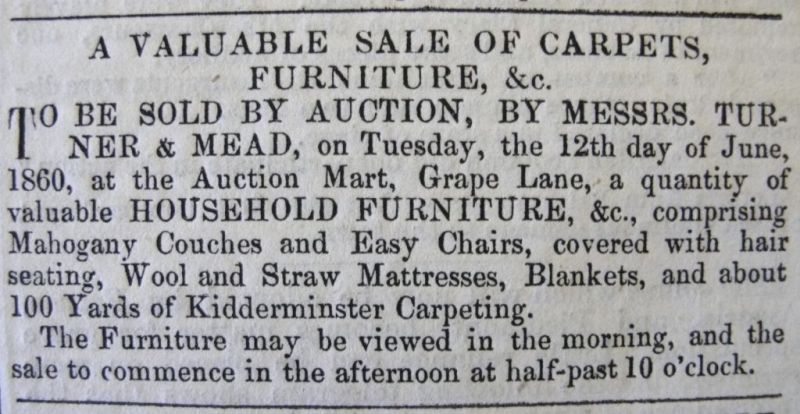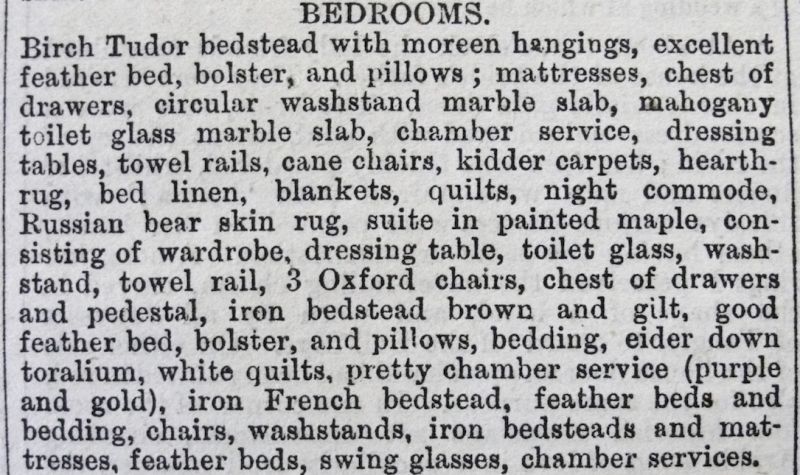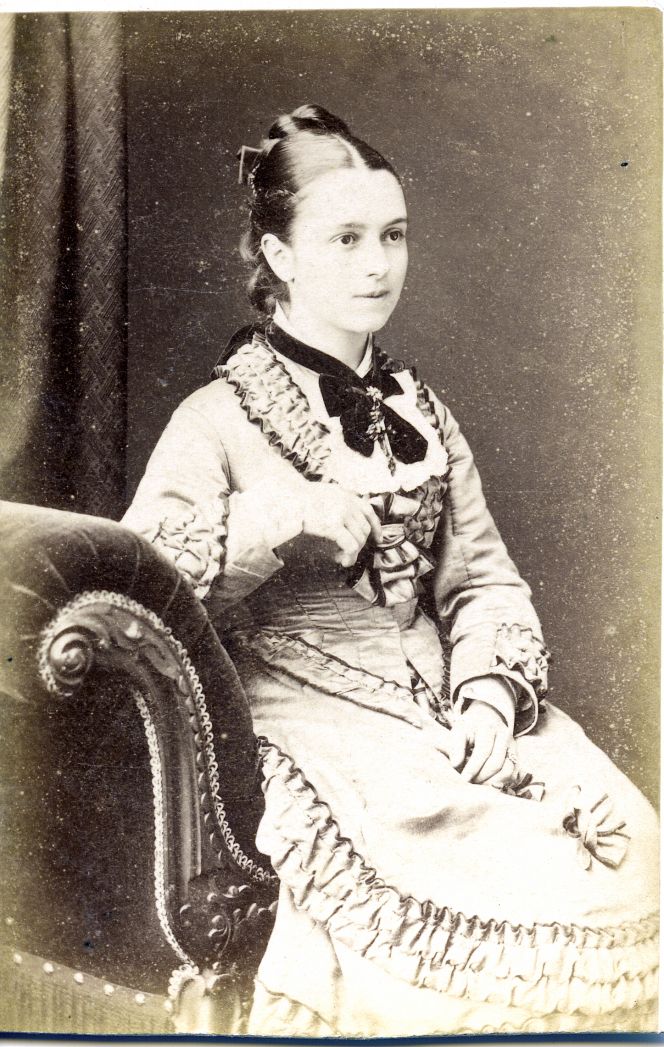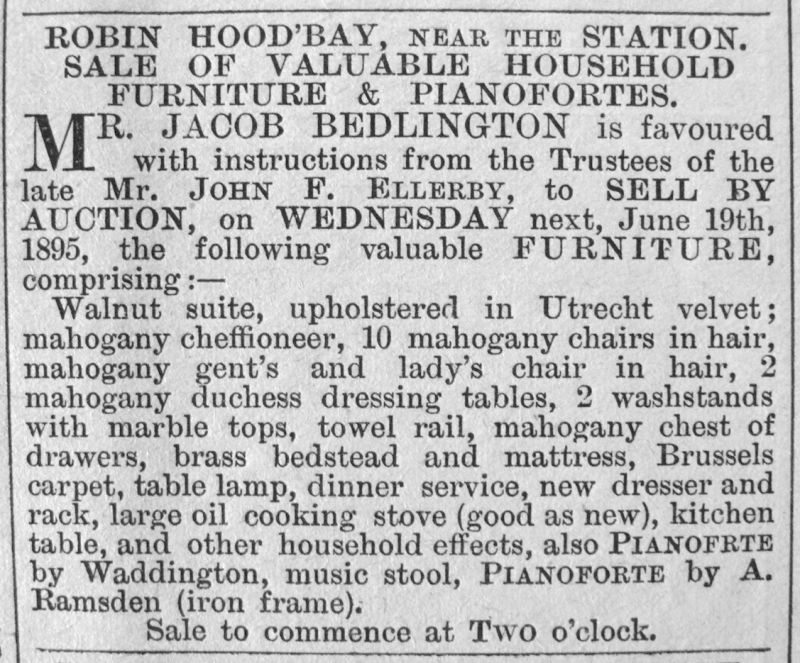ikfoundation.org
Promoting Natural & Cultural History



ESSAYS |
AUCTIONS OF FURNISHING TEXTILES
– Advertisements from 1860 to 1905
During this period – the weekly newspaper Whitby Gazette – published information about forthcoming auctions, which often featured furnishing fabrics, linen and other cloth. This could either be via the sale of a private home or textiles which were auctioned and sold from a draper’s surplus cloth storage. A selection of auction announcements from 1860 to 1905 will give a glimpse into the wide-range of textiles once used in private homes and at a small hotel. Kidderminster carpets, feather beds, linen sheets, quilts, tablecloths, hair mattresses and lace curtains are a few listed examples. Two contemporary local photographs add further links to auctioned textiles in this study about Whitby and its surrounding areas.
 Advertisement in Whitby Gazette, May 1860 (Collection: Whitby Museum, Library & Archive). Photo: Viveka Hansen, The IK Foundation, London.
Advertisement in Whitby Gazette, May 1860 (Collection: Whitby Museum, Library & Archive). Photo: Viveka Hansen, The IK Foundation, London.From the spring of 1860, is shown with an illustration above advertising ‘A Valuable Sale of Carpets, Furniture, &c.’, including among other things large quantities of ‘Kidderminster Carpeting’. This originated with a carpet-making firm established as long ago as 1785 in Kidderminster, Worcestershire. About the middle of the 19th century the production of these popular carpets had accelerated with the introduction of steam power. They were woven to a design of large flowers or leaves with the pattern showing opposite colours on each side of the carpet, so that they could be used with either side uppermost, making them more durable and hard-wearing.
In November the same year (1860), the Whitby Gazette advertised an auction of a different kind: ‘Farming Stock, Crops, And Furniture. Great Fryup. To be Sold by Auction by Mr. Joseph Thomson’. Not only livestock and agricultural tools were to be auctioned from this farm but also ‘Household furniture’, including various items involving textiles: ‘Large Clothes Chest, 2 Feather Beds, Bolsters and Pillows, Straw Mattresses, Blankets, Sheets, and Quilts, Carpeting’. In spring 1865, the ‘Rev. Joseph Hughes’ offered for auction ‘Valuable Furniture’ – from a typical well-off middle-class home. Included were a variety of textile furnishings, though neither table- nor bed linen were sold.
- ‘Capital Brussels carpet (nearly new, measuring 16ft. 8in. by 14ft. 10in) brilliant colours and superior quality
- Hearth rug to match
- New Damask druggets (13ft. by 10ft.)
- 6 mahogany chairs (curled hair and hair seating, covered with damask)
- Mahogany couch and pillow covered with crimson velvet
- Feather cushions, antimacassars, and table mats
- Brussels carpet (16ft. by 12ft. 6in.)
- Hearth rug and drugget
- Good oak couch (curled hair and hair-seating and cushions)
- 2 pairs of green and white window curtains (damask)
- 2 cocoa nut mats, 3 wool ditto
- Excellent 4 post and Tudor bedsteads with hangings complete (all of very good quality)
- 5 feather beds, carpets
- Brussels stair carpets’
Brussels carpets – often mentioned among the auction lots – were also produced in large quantities in Kidderminster. These carpets, too, usually had a large pattern in several colours and a heavy woollen pile, a kind of carpet that conferred status on its owner. Other expensive textile items from this home were the crimson velvet furniture covering and the damask druggets.
An auction announced in spring 1870 advertised a sale of ‘Household Furniture’ in the nearby village of Hinderwell from a farm- or general worker’s home containing no expensive carpets at all. Here, on the other hand, was a striking quantity of table- and bed linen: ‘feather beds, pillows, bolsters mattress, 14 pairs of sheets, 6 pairs of blankets, 6 quilts, 3 rugs, 12 pairs of pillow cases, 6 bolster cases, 6 table covers, great number of towels and napkins, window shades and blinds, carpets, hearth rugs, wool mats’. But such a large collection of domestic textiles makes it clear that the home had been by no means a poor home, as it contained virtually every type of bed and table linen as well as various sorts of floor carpets and window blinds.
 Whitby Gazette 1880, Auction of Household Furniture, showing part of the advertisement ‘Bedrooms’ (Collection: Whitby Museum, Library & Archive). Photo Viveka Hansen, The IK Foundation, London.
Whitby Gazette 1880, Auction of Household Furniture, showing part of the advertisement ‘Bedrooms’ (Collection: Whitby Museum, Library & Archive). Photo Viveka Hansen, The IK Foundation, London.Robert Gray was frequently mentioned as an Auctioneer/Valuer over nearly twenty years (1878-1897). Among the auctions Mr Gray was responsible for included: 8 June 1878 ‘Household Furniture … of the estate of Mr John Ripley, shipowner’, involving textiles typical of a prosperous home. On 15 March 1879, he sold property belonging to John Corner Esq. of Carr Hall, and on 3 July 1880, an auction from a farm outside Whitby included Household Furniture, sheep and wool: ‘13 ewes, 18 lambs, and 6 shearlings. Also, 19 fleeces of Wool.’ The same summer Robert Gray also sold Household Furniture from the property of Capt. Richard Frazer of Esk Terrace, Whitby, some of which appears in the illustration above, including ‘Bedrooms’ featuring particularly large quantities of bedlinen and carpets.
 There are no known contemporary photographs preserved of the premises of Robert Gray & Sons at Silver Street in the West Cliff area of Whitby, but as a connection to furnishing textiles, this lady was portrayed a few streets away in a studio in Khyber House during the 1870s. It looks as if she is sitting on a chaise-longue, covered with strongly-coloured velvet cloth with a decorative hanging fringe. A popular look for drawing-room furniture at the time and furthermore ‘velvet’ was often mentioned as a textile material for furnishing in the auction announcements. (Courtesy of: Whitby Museum, Photographic Collection, 2002/13.16).
There are no known contemporary photographs preserved of the premises of Robert Gray & Sons at Silver Street in the West Cliff area of Whitby, but as a connection to furnishing textiles, this lady was portrayed a few streets away in a studio in Khyber House during the 1870s. It looks as if she is sitting on a chaise-longue, covered with strongly-coloured velvet cloth with a decorative hanging fringe. A popular look for drawing-room furniture at the time and furthermore ‘velvet’ was often mentioned as a textile material for furnishing in the auction announcements. (Courtesy of: Whitby Museum, Photographic Collection, 2002/13.16).Another auctioneer of the 1870s was Mr Flintoft, who held auctions in the Victoria Room at the Angel Hotel, where he sold both ‘Drapery Goods’ and ‘Household furniture’ on various occasions. In the case of drapery goods, the sale was not always by auction, but sometimes could be sold directly in an event that could last five days, during which several drapers could leave goods that needed to be disposed of before new stock could be taken in. Since this type of sale or auction of drapery goods was repeated over the next two decades it must have proved a good way for sellers to rid themselves of large surplus stocks, while giving buyers a chance to acquire quality textiles at heavily reduced prices.
In May 1890, an auction was held at the Wellington Sale Rooms, among other things, offering Household Furniture with carpets particularly well represented:
- ‘22 1/2 yards of Brussels carpet
- 21 yards ditto
- 30 yards ditto’
The same type of popular patterned carpets with heavy pile – Brussels carpets – were also to be found in an auction of property belonging to Mr John F. Ellerby in spring 1895 held in Robin Hood’s Bay, as can be seen from the attached advertisement below.
 Whitby Gazette June 1895, ‘Robin Hoods’bay... Sale of valuable household furniture…’(Collection: Whitby Museum, Library & Archive). Photo: Viveka Hansen, The IK Foundation, London.
Whitby Gazette June 1895, ‘Robin Hoods’bay... Sale of valuable household furniture…’(Collection: Whitby Museum, Library & Archive). Photo: Viveka Hansen, The IK Foundation, London. This photograph of the steep main road in the old parts of Robin Hood’s Bay was taken ca 15 years before the mentioned auction, leading up to where the railway line/station was opened first in 1885, which transported local inhabitants and tourists alike to Whitby or Scarborough. (Courtesy of: Whitby Museum, Photographic Collection. Photo: Frank Meadow Sutcliffe. C12).
This photograph of the steep main road in the old parts of Robin Hood’s Bay was taken ca 15 years before the mentioned auction, leading up to where the railway line/station was opened first in 1885, which transported local inhabitants and tourists alike to Whitby or Scarborough. (Courtesy of: Whitby Museum, Photographic Collection. Photo: Frank Meadow Sutcliffe. C12).Ten years later, Robert Gray was still in business as an auctioneer, but now under the name of Robert Gray & Sons, who held a two-day auction on 1st and 2nd May 1905 of ‘Valuable Household, Furniture and Effects’ from the White House Hotel in Whitby including textile material:
- ‘Large Persian carpet, 40 square yards
- Axminster carpet, 34 yards
- Velvet pile carpet
- 2 carpet squares
- 20 wool and hair mattresses
- 8 rolls canvas
- Stair and landing carpets
- 11 carpets
- 14 feather bolsters and 27 pillows
- 29 pairs lace curtains
- 34 blankets
- 4 coloured quilts
- 18 white counterpanes
- 5 tapestry table covers
- Tapestry curtains
- Velvet pile table cover
- 2 Table cloths
- 4 1/2 dozen dish cloths
- Serge table cover
- 2 chenille dito
- 5 kitchen tablecloths
- 50 cotton sheets
- 146 tea and glass cloths
- 31 pillowcases
- 25 toilet covers
- 50 tray cloths
- 200 damask serviettes
- 32 bath towels
- 50 bedroom towels
- 33 damask tablecloths.’
This comprehensive list gives an interesting insight into what a fairly small hotel – 15-20 beds – needed if guests were to be able to sleep and eat well during their stay. The advertisement also makes clear that the three expensive carpets – Persian, Axminster and Velvet Pile – had all been reserved for ‘Reception Rooms’, while other items merely described as ‘carpets’ and presumably of simpler quality had to suffice for the bedrooms.
Sources:
- Hansen, Viveka, The Textile History of Whitby 1700-1914 – A lively coastal town between the North Sea and North York Moors, London & Whitby 2015. (pp. 77-78 & 136-139. For a full Bibliography and a complete list of notes, see this book).
- Whitby Gazette, 1860-1905 (Whitby Museum, Library & Archive).
- Whitby Museum, Library & Archive and Photographic Collection (Whitby Lit. & Phil.).
ESSAYS
The iTEXTILIS is a division of The IK Workshop Society - a global and unique forum for all those interested in Natural & Cultural History from a Textile Perspective.
Open Access essays - under a Creative Commons license and free for everyone to read - by Textile historian Viveka Hansen aiming to combine her current research and printed monographs with previous projects dating back to the late 1980s. Some essays also include unique archive material originally published in other languages, made available for the first time in English, opening up historical studies previously little known outside the north European countries. Together with other branches of her work; considering textile trade, material culture, cloth manufacturing, fashion, natural dyeing and the fascinating world of early travelling naturalists – like the "Linnaean network" – from a Global history perspective.
For regular updates, and to make full use of iTEXTILIS' possibilities, we recommend fellowship by subscribing to our monthly newsletter iMESSENGER.
been copied to your clipboard




– a truly European organisation since 1988
Legal issues | Forget me | and much more...
It is free to use the information/knowledge in The IK Workshop Society so long as you follow a few rules.
 LEARN MORE
LEARN MORE








